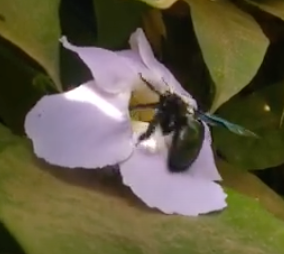Bees and Being in Umbria
I've come to appreciate the natural and animal life in Italy, as you can see from my previous blog, Life with Animals in Rural Italy. But I admit that I've never been fond of insects, I admit. Many are curiously beautiful to look at, but I don't really want them living too close to me. They do, of course. Bugs of all sorts inhabit rural houses, especially. Wasps, spiders, and all species of flying bugs get into ours as unwelcome guests. Or, perhaps they think it's theirs and we're the intruders. Anyway, I'm not a bug-fancier.
Perhaps there is an exception. I've become interested in the incredible bees here. I've never seen bees like these, and wasn't even sure they were bees until I looked it up. I thought they might be beetles because they are so big (easily 1-2") and shiny black, like a tiny new black VW beetle car. But they are identified as Carpenter Bees because they nest in burrows of dead wood. At the house we're in, they congregate at the bushes near old wooden railings (perhaps nesting there).
I've read they're good pollinators and also lay the largest eggs of any insect. Unusual for bees (usually living in large, crowded colonies), these are solitary bees. Female carpenter bees may live alongside their sisters or daughters in small clusters. I believe the bees living beside our house are of this coffee-klatch variety. Their buzz is evident as they swarm around flower bushes. They're big enough to watch as they extract nectar (photos from internet).
To make a prairie it takes a clover and one bee, One clover, and a bee, And revery. The revery alone will do, If bees are few.
--Emily Dickinson
Thinking About Bees
All this has led to thoughts about bees and about being. The physical and metaphorical aspects relating to bees.
Bees buzz through many world mythologies, an archetype of inner circumambulation and internal order. Often they serve as symbolic creatures connecting the natural world to the under- or other-world, conveying themes of immortality and resurrection. Such ideas occur in the inscriptions and drawings of ancient near-east and ancient Aegean as well as Mayan cultures, among others. Bee-insignias have served as symbols of kingship and dynasties, including Napolean's.
Learning more about bees and after reading about the central importance of bees to our planet in Margaret Atwood's After the Flood, I have a new attitude toward them. I walk along the path of a once active apiary (now unattended) near our rented home with respectful admiration. I wouldn't be so presumptuous as to call us friends, but I do my best not to bother them or make a fuss when they cross my path. It encourages me to hear them, knowing there will be more flowers because of them, and honey as well.
Among our first house gifts, here in the Umbrian countryside, were a jar of honey made by bees on this land and a flask of olive oil from these trees. Talk about "eating Italy", indeed!
A Honeyed Recipe
Struffoli are Italian honey-ball fritters. They are golden balls of dough drizzed with honey and best served warm. Typically served at Christmas time in Italy, they're a treat whenever in need. Click here for recipe in English.
Tenement Bees
I created this digital painting (detail shown of work exhibited in Vancouver) called Tenement Bees as a tribute to bees from crowded urban areas, many of them blighted with neglect and decay.
As a long-time city dweller myself, I'm grateful for the opportunity to live in and enjoy the countryside and rural areas wherever I now live. I intended this painting as a tribute to bees who do their bee-ing in settings that offer little and who struggle against circumstances set against them.
More Creative Life News
You can read and see more about Italy, plus other travels and creative adventures by this itinerant artist at Creative Life News click
https://www.janetstrayer.com
Regards, Janet











